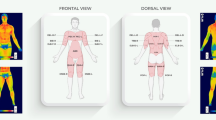Abstract
The aim of this study was to investigate the time evolution of total body skin temperature during running exercise on treadmill. A group of physically active subjects performed two different treadmill exercises, at graded load and at constant load, for a duration of 30 min, in a moderate indoor environment. Thermal maps of the anterior and posterior body regions were gathered, before, during and after the exercise, by means of infrared thermography. Skin temperature of total body was calculated as a combination of individual measurements taken over several body regions. Within the limits due to the relatively small size of the sample group, results typically show a fall in total body skin temperature during the early stages of treadmill exercise. As the exercise progresses, the dynamics of the skin temperature response is affected by the type of exercise, showing a further decrease during the graded load exercise and a slight increase during the constant load exercise. Regionally averaged skin temperatures were found to be lower than total body skin temperature over the most peripheral body regions less involved in running (upper limbs) and comparable with or higher than total body skin temperature over calves and thighs.








Similar content being viewed by others
References
Maughan RJ. Temperature regulation during marathon competition. Br J. Sports Med. 1984;18:257–60.
Lim CL, Byrne C, Lee JKW. Human thermoregulation and measurement of body temperature in exercise and clinical settings. Ann Acad Med Singap. 2008;37:347–53.
Cheuvront SN, Haymes EM. Thermoregulation and marathon running. Biological and environmental influences. Sports Med. 2001;31:743–62.
Charkoudian N. Skin blood flow in adult human thermoregulation: how it works, when it does not, and why. Mayo Clin Proc. 2003;78:603–12.
Ring EFJ, Ammer K. The technique of infrared imaging in medicine. Thermol Int. 2000;10:7–14.
Lahiri BB, Bagavathiappan S, Jayakumar T, Philip J. Medical applications of infrared thermography: a review. Infrared Phys Technol. 2012;55:221–35.
Fernández-Cuevas I, Bouzas Marins JC, Arnáiz Lastras J, Gómez Carmona PM, Piñonosa Cano S, García-Concepción MA, Sillero-Quintana M. Classification of factors influencing the use of infrared thermography in humans: a review. Infrared Phys Technol. 2015;71:28–55.
Clark RP, Mullan BJ, Pugh LGCE. Skin temperature during running—a study using infra-red colour thermography. J Physiol. 1977;267:53–62.
Merla A, Mattei PA, Di Donato L, Romani GL. Thermal imaging of cutaneous temperature modifications in runners during graded exercise. Ann Biomed Eng. 2010;38:158–63.
Fernández-Cuevas I, Sillero-Quintana M, García-Concepción MA, Ribot Serrano J, Gómez-Carmona PM, Bouzas Marins JC. Monitoring skin thermal response to training with infrared thermography. New Stud Athl. 2014;29:57–71.
Fernandes AA, Amorim PRS, Brito CJ, Sillero-Quintana M, Marins JCB. Regional skin temperature response to moderate aerobic exercise measured by infrared thermography. Asian J Sports Med. 2016;7(1):e29243.
Akimov EB. Son’kin VD. Skin temperature and lactate threshold during muscle work in athletes. Hum Physiol. 2011;37:621–8.
Cholewka A, Kasprzyk T, Stanek A, Sieroń-Stołtny K, Drzazga Z. May thermal imaging be useful in cyclist endurance tests? J Therm Anal Calorim. 2016;123:1973–9.
Jones AM, Doust JH. A 1% treadmill grade most accurately reflects the energetic cost of outdoor running. J Sports Sci. 1996;14:321–7.
Nes BM, Janszky I, Wisløff U, Støylen A, Karlsen T. Age-predicted maximal heart rate in healthy subjects: the HUNT Fitness Study. Scand J Med Sci Sports. 2013;23:697–704.
Tanda G. The use of infrared thermography to detect the skin temperature response to physical activity. J Phys Conf Ser. 2015;655:012062.
Tanda G. Skin temperature measurements by infrared thermography during running exercise. Exp Therm Fluid Sci. 2016;71:103–13.
Quesada JIP, Lucas-Cuevas AG, Palmer RS, Pérez-Soriano P, de Anda RMCO. Definition of the thermographic regions of interest in cycling by using a factor analysis. Infrared Phys Technol. 2016;75:180–6.
Ammer K. The Glamorgan Protocol for recording and evaluation of thermal images of the human body. Thermol Int. 2008;18:125–44.
Ludwig N, Formenti D, Gargano M, Alberti G. Skin temperature evaluation by infrared thermography: comparison of image analysis methods. Infrared Phys Technol. 2014;62:1–6.
Bland JM, Altman DG. A note on the use of the intraclass correlation coefficient in the evaluation of agreement between two methods of measurement. Comput Biol Med. 1990;20:337–40.
Choi JK, Miki K, Sagawa S, Shiraki K. Evaluation of mean skin temperature formulas by infrared thermography. Int J Biometeorol. 1997;41:68–75.
Nakayama T, Ohnuki Y, Niwa K. Fall in skin temperature during exercise. Jpn J Physiol. 1977;27:423–37.
Torii M, Yamasaki M, Sasaki T, Nakayama H. Fall in skin temperature of exercising man. Br J Sports Med. 1992;26:29–32.
Chudecka M, Lubkowska A. Temperature changes of selected body’s surfaces of handball players in the course of training estimated by thermovision, and the study of the impact of physiological and morphological factors on the skin temperature. J Therm Biol. 2010;35:379–85.
ASHRAE. Thermal comfort. In: Owen MS, editor. ASHRAE handbook—fundamentals (Chapter 9). SI Edition: Atlanta; 2009.
Smith CJ, Havenith G. Body mapping of sweating patterns in male athletes in mild exercise-induced hyperthermia. Eur J Appl Physiol. 2011;111:1391–404.
Zontak A, Sideman S, Verbitsky O, Beyar R. Dynamic thermography: analysis of hand temperature during exercise. Ann Biomed Eng. 1998;26:988–93.
Author information
Authors and Affiliations
Corresponding author
Rights and permissions
About this article
Cite this article
Tanda, G. Total body skin temperature of runners during treadmill exercise. J Therm Anal Calorim 131, 1967–1977 (2018). https://doi.org/10.1007/s10973-017-6634-4
Received:
Accepted:
Published:
Issue Date:
DOI: https://doi.org/10.1007/s10973-017-6634-4




